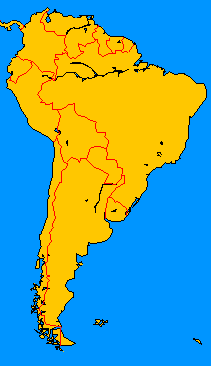The Alpaca
(Lama Pacos)
Future Quote
Anon.
Description
The Alpaca, native to the Andes of Chile, Peru and Bolivia, is kept primarily for its wool, although it is also quite edible. Alpaca wool is prized for its lustre, durability, warmth, and quantity. The wool is usually black or dark brown, but can come in lighter shades.
Some 6000 years ago, the South American peoples began the development of the alpaca from the wild Vicuña
The breeding of alpacas for fiber production, however, didn't commence until around 500 B.C.
Later, the Incas used highly successful breeding programs to further refine the alpaca. Fibre produced during the Inca period is still far superior to anything produced by modern alpacas. Inca breeding practices also developed two distinct alpaca types: the haucaya and the suri.
The arrival of the Spannish in South America during the sixteenth century destroyed the Inca breeding programs, resulting in a decline in both the number of alpacas, and their overall quality.
The introduction of other animals, like sheep, also had a negative effect on the alpaca population, and the decline in the number of alpacas continued until well into the twentieth century.
The forutunes of the alpaca, like that of other lama species, rebounded in the 1960's.
Natural Range

Physical Facts1
- Life Span -
About 15 to 25 years.
- Height -
34-38 inches at the shoulder.
- Weight -
Average Range - 110 - 145 lbs.
- Gestation -
330 days (average)
- Birth -
A single baby 'Cria' is normally delivered without assistance from a standing mother during the daylight. Twins are rare.
- Babies -
As for llamas.
- Reproduction -
As for llamas.
- Colour -
- Health -
- Fibre -
Alpaca is one of the world's most desirable, elegant and elite fibres. The fine, warm, durable, and lustrous fibre has been used by native Andean weavers for at least 3000 years to create some of the world's most beautiful and technically complex textile masterpieces. The alpaca and llama fibre is technically hair due to its cellular composition. Magnified cutaways show that it is a somewhat tubular hair with a hollow core, structurally different from the solid fibres of sheep and most other wool-bearing animals. This unique structure may account for the remarkable warmth and insulating quality of the fibre and contribute to its tensile strength and durability.
Taxonomy
Phylum
Chordata
Class
Mammalia
Order
Artiodactyla
Sub-order
Tylopoda
Family
Camelidae
Genus
Lama
Species
Pacos
Comparative Camelid Taxonomy (CSS Version - 60.8K)
Comparative Camelid Taxonomy (Text Version)
Links to Other Information
1. Much of the Physical Facts information is shamelessly filched (virtually word for word) from a brochure produced by the Parkland Llama & Alpaca Club of Central Alberta. At the time the brochure was produced, there were 26 member farms.
Camelid Country Home Page.
Page last updated May 20, 2000.
Page Maintained by John Fleming.
Copyright © 1998-2000 John Fleming.
Background Image Copyright © 1997 Gini Schmitz.
You are visitor number
to the Alpaca Page since September 20, 1998.
This page hosted by![]()
Get your own Free Home Page